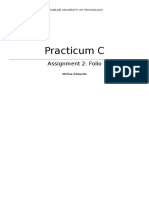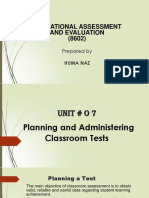Student's Diversity
Student's Diversity
Uploaded by
Rejesh MeladCopyright:
Available Formats
Student's Diversity
Student's Diversity
Uploaded by
Rejesh MeladOriginal Title
Copyright
Available Formats
Share this document
Did you find this document useful?
Is this content inappropriate?
Copyright:
Available Formats
Student's Diversity
Student's Diversity
Uploaded by
Rejesh MeladCopyright:
Available Formats
MELAD, REJESH D.
Strategies for Teaching Diverse Students
1) ESTABLISH CARING RELATIONSHIP
A caring teacher can transform the school experience especially for students who face
enormous difficulties, such as dropping out or dysfunctional home lives. Compassion is
the key in teaching diverse students. An effective classrooms compose strengths of
diverse students are recognized, respected, and valued as students and connected with
them personally. Building a caring relationship within students help them cultivate a
sense of belonging no matter what gender, race and nationality you are.
2) Use of Collaborative Learning
Research has consistently endorsed the use of structured cooperative learning as a
major strategy for teaching in diverse learning environments. Collaborative learning
restructures classroom away from the traditional lecture to small group work requiring
intensive interaction between students and teacher while working through projects.
Collaborative learning is supposed to enhances students build upon their personal
experiences while working with other students. With collaborative learning, classroom
experiences have been found to exert positive effects on a diverse array of student’s
outcomes.
Cooperative learning provides learners with opportunities to build confidence and self-
esteem among students.
Take the opportunity to allow students to share their diversity with their peers.
3) Communicating with parents and community
By understanding different patterns of families, parent’s needs, and parental workload,
teachers can plan activities and improve parental involvement, making it more
meaningful. Teachers need to stress the importance of the context in which family lives
to help teachers consider the diverse backgrounds and the variety of needs families
they will encounter.
Communicating with parents could help explore how can classroom teachers can
establish and maintain positive learning environment. Recognising the cultural diversity
of school communities helps meet the educational and welfare needs of students and
their families. It aids in the planning of teaching and learning activities.
4) Encourage learners to share their personal history and experiences.
By encouraging them to tell stories about their personal life will create harmony and
connection between learners and teachers. Through this connection, the learners
embrace their differences and evolve in this world.
You might also like
- Reviewer EthicsDocument11 pagesReviewer EthicsRejesh Melad100% (1)
- Adult Learning and 4as - FinalDocument33 pagesAdult Learning and 4as - FinalAlain Capapas Maestrado75% (4)
- Tataiako 1Document20 pagesTataiako 1api-329258263No ratings yet
- Assignment 2 Folio FinalDocument18 pagesAssignment 2 Folio Finalapi-339908787No ratings yet
- Sarah Lesson Plan 2Document2 pagesSarah Lesson Plan 2api-260894328No ratings yet
- Nicholls and Nicholls ModelDocument10 pagesNicholls and Nicholls ModelJohn Carlo QuianeNo ratings yet
- Fundamentals of Organizing and Organizational StructureDocument18 pagesFundamentals of Organizing and Organizational StructureRejesh MeladNo ratings yet
- cHAPTER 6 - ENSURINGDocument1 pagecHAPTER 6 - ENSURINGRejesh Melad100% (6)
- Squiggle Park Mini LessonDocument11 pagesSquiggle Park Mini Lessonapi-420730127No ratings yet
- Grammar Post-Lesson EvaluationDocument2 pagesGrammar Post-Lesson EvaluationParaskevi AndreopoulouNo ratings yet
- When The Game Stands TallDocument4 pagesWhen The Game Stands TallmikewolzNo ratings yet
- Teaching MethodsDocument5 pagesTeaching Methodsmitchbitch69No ratings yet
- Intended VsDocument14 pagesIntended VsRyan Morales67% (3)
- 2.8 Teaching in A Diverse ClassroomDocument4 pages2.8 Teaching in A Diverse ClassroomRosmalia KasanNo ratings yet
- (Prelim) - Educational Reforms (The K-12 Curriculum Example)Document7 pages(Prelim) - Educational Reforms (The K-12 Curriculum Example)nicolai cortesNo ratings yet
- My Classroom Management PlanDocument21 pagesMy Classroom Management Planapi-256021953100% (1)
- 20.teacher Centered Vs Learner Centered ParadigmsDocument2 pages20.teacher Centered Vs Learner Centered ParadigmsManisha Pachauri100% (1)
- Presentation Topic Unit # 06 Qualities of A Good TestDocument18 pagesPresentation Topic Unit # 06 Qualities of A Good TestFazal HayatNo ratings yet
- Learning Objectives and OutcomesDocument37 pagesLearning Objectives and OutcomesBhawana SinghNo ratings yet
- Collaborative LearningDocument6 pagesCollaborative LearningMANISHA DASNo ratings yet
- Choice Based Credit System (CBCS)Document38 pagesChoice Based Credit System (CBCS)Aravind B PatilNo ratings yet
- Learning Styles: Taught With Methods and Approaches Responsive To Their Learning Styles"Document12 pagesLearning Styles: Taught With Methods and Approaches Responsive To Their Learning Styles"Hariesz HorushiNo ratings yet
- Designing Teaching and Learning Assessment 2 - Lesson Plan AnalysisDocument15 pagesDesigning Teaching and Learning Assessment 2 - Lesson Plan Analysisapi-511815350No ratings yet
- Constructism and 5 E'sDocument1 pageConstructism and 5 E'sOmicron TrentNo ratings yet
- Seminar Method of LearningDocument14 pagesSeminar Method of LearningRAKESH KUMAR BAROI100% (1)
- Educational Psychology AssignmentDocument4 pagesEducational Psychology AssignmentPriya MalikNo ratings yet
- Dr. Sunanda RoyDocument5 pagesDr. Sunanda RoyAnonymous CwJeBCAXp100% (1)
- Theory of LearningDocument24 pagesTheory of LearningShohag ID CenterNo ratings yet
- Teaching and Learning ModalityDocument14 pagesTeaching and Learning ModalityJosephine AyaNo ratings yet
- Social Cognitive Theory Lesson PlanDocument5 pagesSocial Cognitive Theory Lesson Planapi-240286998100% (1)
- Interview With TeacherDocument5 pagesInterview With Teacherapi-457860691No ratings yet
- CL EDU 503 Sample Constructivist Lesson PlanDocument7 pagesCL EDU 503 Sample Constructivist Lesson PlanCheska Lorena100% (2)
- Technology For Teaching (Onc2) : 1.3 Meaning of Educational TechnologyDocument5 pagesTechnology For Teaching (Onc2) : 1.3 Meaning of Educational Technologysangitha9777100% (1)
- Research Based Assingment AIOU B.ed 1.5 Programme Course Code 8601Document15 pagesResearch Based Assingment AIOU B.ed 1.5 Programme Course Code 8601Muhammad Zartash Haider100% (1)
- Philosophy of EducationDocument6 pagesPhilosophy of EducationShanna OsinskiNo ratings yet
- The Internet in Teaching and LearningDocument12 pagesThe Internet in Teaching and LearningCinderella Rodemio0% (1)
- Affective Domain PDFDocument15 pagesAffective Domain PDFLoren LopezNo ratings yet
- Brain DevelopmentDocument10 pagesBrain Developmentapi-269732799No ratings yet
- Unit 7Document26 pagesUnit 7Aamir HabibNo ratings yet
- Nep 2020Document46 pagesNep 2020CHHOTE LAL SHAWNo ratings yet
- The 4 Stages of Cognitive DevelopmentDocument14 pagesThe 4 Stages of Cognitive Developmentelphie oziansNo ratings yet
- Learning and Teaching: Submitted by Annie Terrence B.ed First Year Department of ENGLISHDocument16 pagesLearning and Teaching: Submitted by Annie Terrence B.ed First Year Department of ENGLISHAnnie TerrenceNo ratings yet
- Lesson Plan Student: Josue Mena Ochoa Subject/Concepts: English/ Writing and Comprehension Grade Level: 12Document5 pagesLesson Plan Student: Josue Mena Ochoa Subject/Concepts: English/ Writing and Comprehension Grade Level: 12api-540998942No ratings yet
- BTE Assignment 3Document5 pagesBTE Assignment 3Thato MalapelaNo ratings yet
- The Scope of Curriculum ReportDocument4 pagesThe Scope of Curriculum ReportDarlene OrbetaNo ratings yet
- Asessment of For As LearningDocument20 pagesAsessment of For As LearningGerald Ryan BartolomeNo ratings yet
- Behavioral ObjectivesDocument4 pagesBehavioral ObjectivesDilruk GallageNo ratings yet
- Importance of Teacher Training in PakistanDocument3 pagesImportance of Teacher Training in Pakistanather siddiqiNo ratings yet
- Leaning Unit 2 The Teacher As A Caring Professional - 5 April 2024Document9 pagesLeaning Unit 2 The Teacher As A Caring Professional - 5 April 2024Siyasanga SotyingwaNo ratings yet
- Addressing Diverse Student Needs Through Differentiated InstructionDocument1 pageAddressing Diverse Student Needs Through Differentiated InstructionPrincess May Geronimo ParaynoNo ratings yet
- EMA 511 Syllabus - Fall 2020Document27 pagesEMA 511 Syllabus - Fall 2020Sharney WilksNo ratings yet
- Behaviorism: Philosophy in EducationDocument18 pagesBehaviorism: Philosophy in EducationKaye100% (1)
- CURRICULUMDocument54 pagesCURRICULUMJoseph MusondaNo ratings yet
- Teachers Role and Teachers SkillsDocument8 pagesTeachers Role and Teachers SkillsElvitaNo ratings yet
- Edug 808 Unit Plan-FinalDocument26 pagesEdug 808 Unit Plan-Finalapi-273543630No ratings yet
- CM FullDocument155 pagesCM FullStephen AriantoNo ratings yet
- Classroom Management SystemDocument7 pagesClassroom Management Systemajextope100% (1)
- Module 05. Implementing and Evaluating The CurriculumDocument4 pagesModule 05. Implementing and Evaluating The CurriculumCharlene A. BoNo ratings yet
- Types of LiteracyDocument34 pagesTypes of LiteracyAchmad Furqon Syaifullah100% (1)
- TQMDocument16 pagesTQMDr.Femila PangatNo ratings yet
- Unit 1 - Working in ClassroomsDocument27 pagesUnit 1 - Working in ClassroomsMpho VixNo ratings yet
- Elements of Teaching - The Teacher (Principles of Teaching 1)Document17 pagesElements of Teaching - The Teacher (Principles of Teaching 1)Shiellah JuaniteNo ratings yet
- Assignment 8601Document24 pagesAssignment 8601arifiqra246100% (1)
- WILI3606 Group Assignment PP PresentationDocument10 pagesWILI3606 Group Assignment PP Presentationhafs.ganieNo ratings yet
- 2 Eed 15 ModuleDocument31 pages2 Eed 15 ModuleNor-inNo ratings yet
- Strategies For Working With Diverse LearnersDocument6 pagesStrategies For Working With Diverse LearnersAntonia AminNo ratings yet
- Preparation of Teachers of Diverse Classroom BedDocument12 pagesPreparation of Teachers of Diverse Classroom Bedlibishalibi1311No ratings yet
- RESLIE-RESUMEDocument3 pagesRESLIE-RESUMERejesh MeladNo ratings yet
- Personal Reviewer (R.A. 9646)Document11 pagesPersonal Reviewer (R.A. 9646)Rejesh MeladNo ratings yet
- Real Estate Service Act of The PHDocument5 pagesReal Estate Service Act of The PHRejesh MeladNo ratings yet
- Learning Task TTPDocument1 pageLearning Task TTPRejesh Melad50% (2)
- Solutions To Real Estate FinanceDocument1 pageSolutions To Real Estate FinanceRejesh MeladNo ratings yet
- SolutionsDocument2 pagesSolutionsRejesh Melad100% (1)
- CHAPTER 8 ANSWER AaDocument1 pageCHAPTER 8 ANSWER AaRejesh MeladNo ratings yet
- 4 Measures of Centrality: Mean, Median, Mode, Grouped DataDocument18 pages4 Measures of Centrality: Mean, Median, Mode, Grouped DataRejesh MeladNo ratings yet
- Chapter 9 TTP Research ConnectionDocument1 pageChapter 9 TTP Research ConnectionRejesh Melad100% (1)
- Activity Gardner Theory Essay - Principles of TeachingDocument1 pageActivity Gardner Theory Essay - Principles of TeachingRejesh MeladNo ratings yet
- Learning Activities For Chapter 5 AnsDocument3 pagesLearning Activities For Chapter 5 AnsRejesh MeladNo ratings yet
- Domain 7. Personal Growth and Professional DevelopmentDocument7 pagesDomain 7. Personal Growth and Professional DevelopmentRejesh Melad100% (3)
- Society Demands From A Teacher As A PersonDocument6 pagesSociety Demands From A Teacher As A PersonRejesh MeladNo ratings yet
- LESSON 3 Activity - ED TECHDocument1 pageLESSON 3 Activity - ED TECHRejesh MeladNo ratings yet
- Icebreaker!: Two Truths and 1 LieDocument45 pagesIcebreaker!: Two Truths and 1 LieRejesh MeladNo ratings yet
- Behaviorist PerspectiveDocument32 pagesBehaviorist PerspectiveRejesh MeladNo ratings yet
- Enhanced School Improvement Plan: Madalunot Elementary School 107298 Madalunot Calaca, Batangas School Year 2019 - 2022Document1 pageEnhanced School Improvement Plan: Madalunot Elementary School 107298 Madalunot Calaca, Batangas School Year 2019 - 2022Rejesh MeladNo ratings yet
- Table of ContentsDocument1 pageTable of ContentsRejesh MeladNo ratings yet
- List of Acronyms: Deped - Sip - Aip - Pdaet - Almes - Bagtip - Help - BBNB - DTR - Ects - LingapDocument1 pageList of Acronyms: Deped - Sip - Aip - Pdaet - Almes - Bagtip - Help - BBNB - DTR - Ects - LingapRejesh MeladNo ratings yet
- Phase ChangesDocument8 pagesPhase Changesapi-313517608No ratings yet
- Yeshivat He'Atid Annual Report 2013Document11 pagesYeshivat He'Atid Annual Report 2013pixelkatestudioNo ratings yet
- A Short Guide To Action Research (Notes)Document5 pagesA Short Guide To Action Research (Notes)Mohamed Sabbah100% (1)
- Edarabia ADEC Lycee Francais Theodore Monod Private School 2015 2016 PDFDocument16 pagesEdarabia ADEC Lycee Francais Theodore Monod Private School 2015 2016 PDFEdarabia.comNo ratings yet
- Education As An Intervention Strategy To Eliminate and Prevent Child LabourDocument165 pagesEducation As An Intervention Strategy To Eliminate and Prevent Child LabouranaamikaaNo ratings yet
- Actividades de Refuerzo de Inglés 1º E.S.ODocument22 pagesActividades de Refuerzo de Inglés 1º E.S.OAmalia Reyes FuentesNo ratings yet
- 2017 SPLASH Program Booklet FinalDocument2 pages2017 SPLASH Program Booklet FinalAnonymous 7XjTCrbHCNo ratings yet
- A Portfolio Presented To The Faculty of College of Education-STI West Negros UniversityDocument50 pagesA Portfolio Presented To The Faculty of College of Education-STI West Negros UniversityGodfrey Loth Sales Alcansare Jr.No ratings yet
- Alana Stovall CV 2016Document2 pagesAlana Stovall CV 2016Alana StovallNo ratings yet
- Children With Cerebral Palsy in Mainstream Physical Ed Case Study Student Teacher ExperiencesDocument15 pagesChildren With Cerebral Palsy in Mainstream Physical Ed Case Study Student Teacher ExperiencesLyana A. RahmanNo ratings yet
- AmberDocument5 pagesAmberMamaJoy CatudanNo ratings yet
- Learning and Development 3Document6 pagesLearning and Development 3cattleya abelloNo ratings yet
- 585 - Knowledge Translation GoodDocument8 pages585 - Knowledge Translation Goodapi-264842331No ratings yet
- Lesson Plans Grade Nine Media StudiesDocument12 pagesLesson Plans Grade Nine Media Studiesapi-395442607No ratings yet
- 01.E. Instructor Responsibilities and ProfessionalismDocument6 pages01.E. Instructor Responsibilities and ProfessionalismJose DiasNo ratings yet
- Core Lesson PlanDocument2 pagesCore Lesson Planapi-401944586No ratings yet
- Article Music EducDocument23 pagesArticle Music EducMonica D'gorgeousNo ratings yet
- Monday Tuesday Wednesday Thursday Friday: GRADES 1 To 12 Daily Lesson LogDocument3 pagesMonday Tuesday Wednesday Thursday Friday: GRADES 1 To 12 Daily Lesson LogJoan PurificacionNo ratings yet
- Assure Model Lesson Plan Lydia DunlevyDocument4 pagesAssure Model Lesson Plan Lydia Dunlevyapi-299916070No ratings yet
- John SmithDocument1 pageJohn SmithTed CarpenterNo ratings yet
- Students REGULATION 5144.1 Board of Trustees Churchill County School District TransportationDocument14 pagesStudents REGULATION 5144.1 Board of Trustees Churchill County School District TransportationDonquixote DoflamingoNo ratings yet
- Romeo and Juliet - Exercises 1Document4 pagesRomeo and Juliet - Exercises 1Nicolle AmarieiNo ratings yet
- For Teaching ProfessionDocument255 pagesFor Teaching ProfessionDiaz Jay-Ann50% (4)
- Curriculum DevelopmentDocument42 pagesCurriculum DevelopmentMarvin Vinas100% (3)
- 50 Ideas, Tricks, and Tips For Teaching 7th Grade: 1. Connect The Middle School YearsDocument19 pages50 Ideas, Tricks, and Tips For Teaching 7th Grade: 1. Connect The Middle School YearsSushimita Mae Solis-AbsinNo ratings yet
- Design BriefDocument2 pagesDesign Briefapi-319898007No ratings yet















































































































